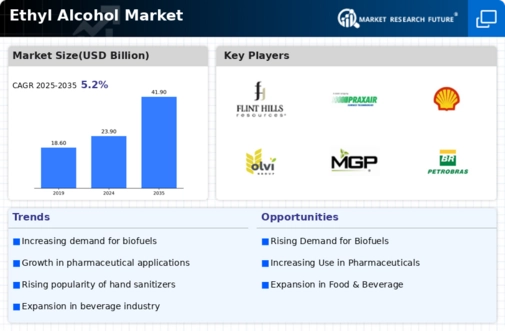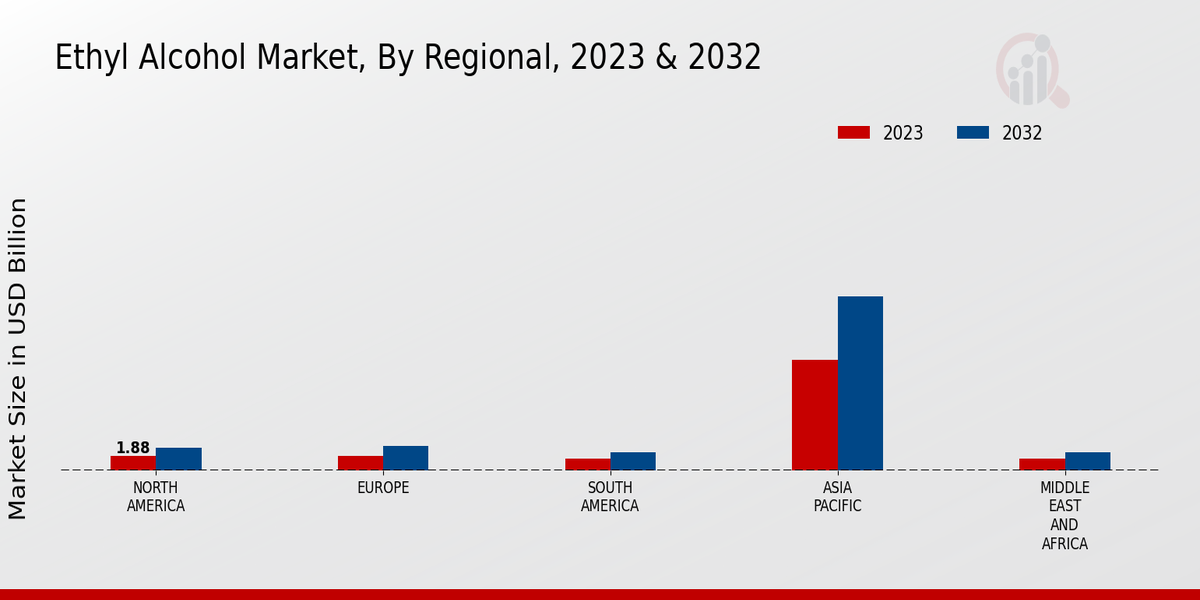Market Growth Projections
Rising Demand for Biofuels
The Global Ethyl Alcohol Market Industry experiences a notable surge in demand for biofuels, driven by the increasing emphasis on sustainable energy sources. Ethyl alcohol serves as a key component in the production of biofuels, which are gaining traction as alternatives to fossil fuels. Governments worldwide are implementing policies to promote renewable energy, contributing to this trend. For instance, the market is projected to reach 23.9 USD Billion in 2024, reflecting a growing inclination towards eco-friendly energy solutions. This shift not only supports environmental goals but also enhances energy security, indicating a robust future for the Global Ethyl Alcohol Market Industry.
Growth in Food and Beverage Sector
The Global Ethyl Alcohol Market Industry benefits from the robust growth in the food and beverage sector, where ethyl alcohol is widely used as a flavoring agent and preservative. The increasing consumer preference for alcoholic beverages, particularly craft spirits and premium products, drives the demand for high-quality ethyl alcohol. Additionally, the trend towards natural and organic ingredients in food products further enhances the market's prospects. As the food and beverage industry continues to expand, the Global Ethyl Alcohol Market Industry is likely to see sustained growth, with a projected CAGR of 5.24% from 2025 to 2035, reflecting the sector's resilience and adaptability.
Regulatory Support for Ethanol Blending
Regulatory support for ethanol blending in fuels is a critical driver for the Global Ethyl Alcohol Market Industry. Governments are increasingly mandating the incorporation of ethanol in gasoline to reduce greenhouse gas emissions and promote renewable energy. This policy shift not only stimulates demand for ethyl alcohol but also aligns with global sustainability goals. As countries implement stricter emissions regulations, the need for ethanol as a blending agent is expected to rise. This regulatory environment creates a favorable landscape for the Global Ethyl Alcohol Market Industry, potentially leading to increased investments and innovations in production and distribution.
Expansion of Pharmaceutical Applications
The Global Ethyl Alcohol Market Industry is significantly influenced by its expanding applications in the pharmaceutical sector. Ethyl alcohol is utilized as a solvent and preservative in various medicinal formulations, including tinctures and antiseptics. The increasing prevalence of chronic diseases and the rising demand for effective healthcare solutions are propelling the growth of this segment. As pharmaceutical companies innovate and develop new products, the need for high-quality ethyl alcohol remains paramount. This trend suggests a promising trajectory for the market, with projections indicating a potential market size of 41.9 USD Billion by 2035, underscoring the importance of ethyl alcohol in modern medicine.
Technological Advancements in Production
Technological advancements in the production of ethyl alcohol are reshaping the Global Ethyl Alcohol Market Industry. Innovations in fermentation and distillation processes enhance efficiency and yield, reducing production costs and environmental impact. These advancements enable manufacturers to meet the growing demand for high-purity ethyl alcohol across various applications, including industrial and consumer products. Furthermore, the integration of automation and data analytics in production facilities streamlines operations, ensuring consistent quality. As these technologies evolve, they are likely to bolster the market's competitiveness, positioning the Global Ethyl Alcohol Market Industry for sustained growth in the coming years.


















